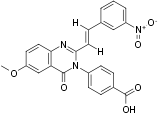Overview
- Hansen, K.B. and Traynelis, S.F. (2011) J. Neurosci. 31, 3650.
 Alomone Labs QNZ 46 inhibits NMDA receptors (NR1+NR2C) expressed in Xenopus oocytes.A. Representative time course of NR1/NR2C currents, elicited by transient stimulation with 100 µM glutamate + 100 µM glycine every 50 sec, while membrane potential was held at -80 mV, and reversibly inhibited by 4 µM and 20 µM QNZ 46 (#Q-270). B. Superimposed current traces from the recording shown in A, following application of control, 4 µM and 20 µM QNZ-46. Transient stimulation is indicated by an arrow.
Alomone Labs QNZ 46 inhibits NMDA receptors (NR1+NR2C) expressed in Xenopus oocytes.A. Representative time course of NR1/NR2C currents, elicited by transient stimulation with 100 µM glutamate + 100 µM glycine every 50 sec, while membrane potential was held at -80 mV, and reversibly inhibited by 4 µM and 20 µM QNZ 46 (#Q-270). B. Superimposed current traces from the recording shown in A, following application of control, 4 µM and 20 µM QNZ-46. Transient stimulation is indicated by an arrow.
QNZ 46 is a potent and selective antagonist of GluN2C/GluN2D-containing N-methyl-D-aspartate (NMDA) receptors. It inhibits NMDA receptor function in a non-competitive and voltage-independent manner1. The compound demonstrates IC50 value of 3.9 and 7.1 µM for NR2D and NR2C containing receptors respectively and 182 and over 193 µM for NR2A and NR2B-containing receptors1.
NMDA receptors are heterotetrameric channels formed by the assembly of two obligatory GluN1 and two GluN2/GluN3 subunits. They play an important role in a variety of cellular processes and physiological functions such as, synaptic plasticity, learning and memory formation, addiction and stroke, and are important components in glutamate excitotoxicity. NMDA receptors are also involved in many neurodegenerative conditions including Alzheimer’s disease2.

